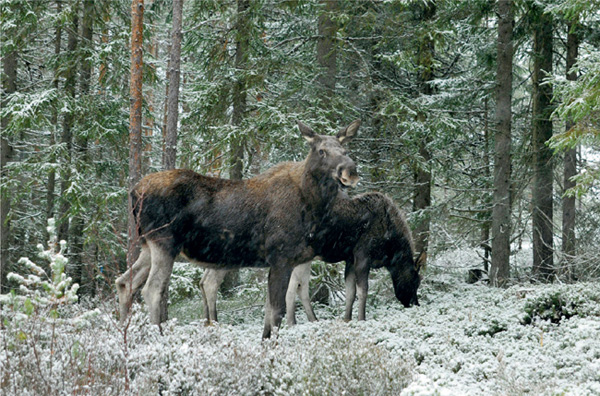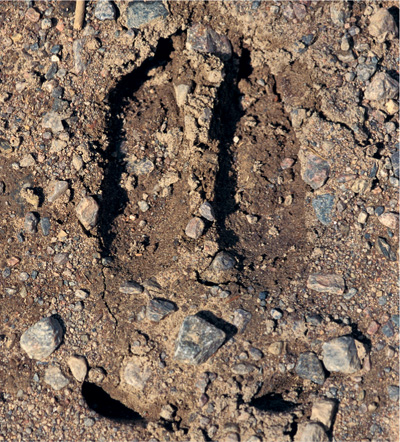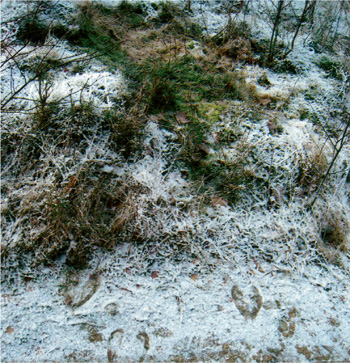
Alces alces
Elk are the largest species of deer in Europe, and on account of their size alone cannot be confused with other animals. The coat is dark brown to almost completely black; the legs are lighter, especially in females. The ears are large and mobile.
A full-grown female can reach a height at the shoulder of 170–180 cm, the male about 180–220 cm; Elk are 2–3 m in length, and the relatively short tail is about 10 cm long. There is a slight hump on the back. The large upper lip juts over the lower jaw, and a fold of skin hangs below the neck, covered with long hairs. An adult female can weigh 340–400 kg, an adult male, 380–500 kg, but in the northernmost regions, just before the mating season in September/October, up to 1 ton. The male’s antlers are set at an angle of almost 90 degrees from the head, with the palmations pointing upwards.
Elk live in open conifer forest, particularly with scattered deciduous trees, extensive ground vegetation, and accessible water nearby. They are most active from dusk until dawn.
A female Elk with a large calf. LGA.


In summer, Elk feed on leaves and young branches of willows, sorbs, ashes, birches, and oaks, as well as plants such as willowherbs, meadowsweet, water lilies, and other succulent aquatic plants. In autumn they eat bell heather and blueberries, apples, wild oats, and other kinds of cereal. Elk may also look for food in fields of rape, clover, and peas. In winter they eat mostly pine needles, the branches of young pine and deciduous trees, and the bark of wild service tree, ash, and pine.
Elk tracks are distinctive in practically all types of terrain; they are 12–16 cm long and about 13 cm wide; the female’s footprints are smaller than those of the male. The dew claw is positioned lower on the hoof than in other deer, with the exception of Reindeer.
On soft terrain you can often make out the mark of the dew claws. The footprints may be significantly splayed, and the stride is 150–200 cm. Elk tracks are larger than those of other deer but somewhat similar to cattle tracks. A female’s hooves are not as pointed, and overall her tracks are shorter and more rounded, and may not show the imprint of the dew claw. The footprints of Red Deer are smaller, while those of Reindeer are more rounded.
Elk tracks in deep snow. JT.

An Elk footprint with the dew claw distinctly visible. LG.

Elk feed on small pine branches up to a height of 3 m; larger branches may be broken and left hanging. The chewed branches have frayed edges. In order to reach branches higher up, Elk press down on a tree trunk with their chest, and sometimes the tree breaks under the pressure. Elk leave very powerful gnaw marks on bark, especially on European aspen. You can see the distinct marks of the lower teeth; they leave wide grooves running up the trunk (cf. p. 47), as if the work of a carpenter, and these can reach to about 2.5 m.
Elk scat is easily identified based on its shape and size. It is left in piles, and the individual segments are round and roughly the shape of a large grape. The scat can be slightly fatter at one end and is 2– 3 cm long and 1.5–2 cm wide. In summer the scat is very dark, almost black, and soft. If Elk eat a lot of succulent plants, the ‘grapes’ can merge to form a somewhat indistinct mass resembling a cowpat. In the winter the ‘grapes’ are lighter and harder, since they consist mostly of large fibres.

In winter, Elk eat large numbers of spruce needles. BW.

In both summer and winter, you can find areas where Elk have settled down to ruminate. In summer the grass is trampled in a 1 m radius around a rest area, but a rest area is most easily identified in snow or a heavy frost, and the animal’s scat will often be found nearby.
Normal Elk scat. AK.


Above: The body heat of an Elk has melted a thin layer of snow in its rest area. L-HO.
Below: A male Elk, the dream of every hunter. TF.

In August and September, the Elk rubs the velvet off its new antlers, using young trees and larger bushes. During this process, branches can break off, and the bark can hang in strips.
During the mating season, from the end of September to the beginning of October, the male uses his feet to create a hollow in the ground 1–1.5 m wide in which he urinates. When it rains, these rutting pits can become stinking sloughs in which the Elk lies and rubs mud into his coat. Females and one-year old calves may also wallow in the mud.
Elk are highly mobile, especially young males. They often use the same trails in the forest, which can be completely trampled down after time. When Elk pass near barbed wire fences, you can often find long greyish brown hairs caught on the fence.